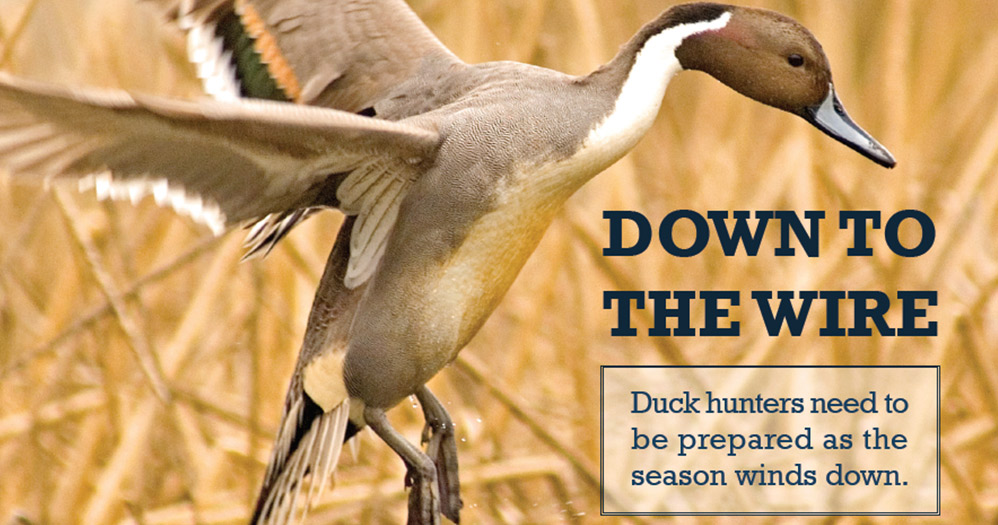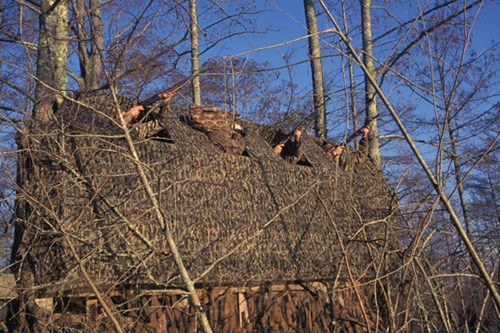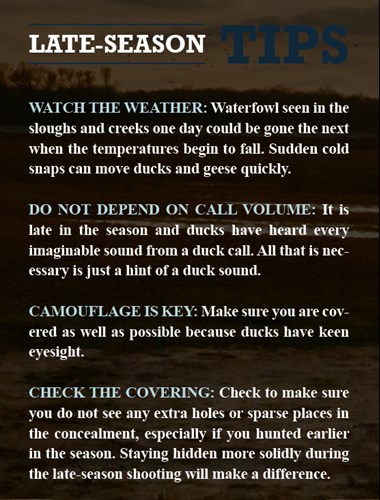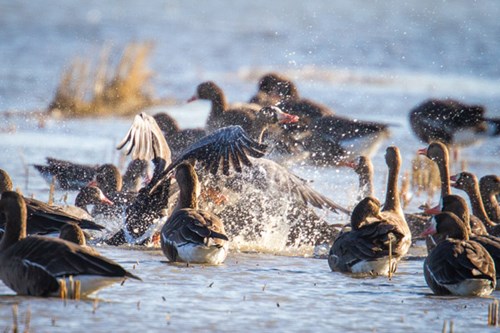Mississippi Outdoors: Down to the Wire
1/8/2018 9:45:32 AM
By Buster Wolfe

Mississippi duck hunters who have waited to the last possible moment to knock down a limit of mallards this season are hoping that the weather, the water, and the birds work in their favor.
Because the hunting season for waterfowl regularly ends on the last Sunday in January each year, the last week in the first month is reserved for the diehard duck hunters who have been waiting for the dense flocks that cover the sky.
Temperatures in Mississippi usually do not reach freezing until December, but they begin to become the daily menu in January, especially in the northern counties.
Later during the hunting season, one prized target of the hunter is the Northern pintail duck, which has the latest checkout time in the migration process. Those Mississippians who have already filled their freezers with the season’s deer limit often change their focus to ducks in the later days of the season.

First, the ducks have to be where you are hunting. Without ducks, which are being pushed southward by the icy winds from Canada, hunting becomes wishing there was something to shoot at.
Houston Havens, the Mississippi Department of Wildlife, Fisheries, and Parks (MDWFP) Waterfowl Program Coordinator, said early signs point to an optimistic season for duck hunters in the Magnolia State.
“Heading into the summer, breeding duck populations were once again very high and habitat conditions were good in many key areas for waterfowl production across the northern U.S. and Canada,” he said. “High breeding populations are always a positive aspect waterfowl hunters look for as an early indicator of the upcoming hunting season’s potential.”
The areas that affect the production of waterfowl for the upcoming season can be habitat troubles and natural predators in the pothole region of Canada and the northern United States. The U.S. Fish and Wildlife Service released its annual duck survey in August for Mississippi’s hunters.
This year, the survey showed the number of ducks was similar to the 2016 estimate, which was the fifth-largest estimate on record. The total population was estimated at 47.3 million breeding ducks.
Improved wetland conditions in many important waterfowl breeding areas accounted for a large number of ducks and geese. Most of the ponds (the unit of measure for wetland abundance on the prairies) that were counted in May increased from around 5 million in 2016 to almost 6.1 million in 2017.
Having a place for migratory waterfowl in the state’s habitat is vitally important. Ducks and geese look to water areas for feeding and nesting. In Mississippi, the MDWFP’s Wildlife Management Areas (WMAs) are prime hunting grounds.
Hunters can hunt on their own at many areas like Sunflower, Malmaison, O’Keefe, Sky Lake, Pascagoula, Nanih Waiya, or Canal Section WMAs. A more-defined hunting experience with defined hunting units and on-site personnel is available at WMAs like Howard Miller, Charlie Capps, Mahannah, Trim Cane, Tuscumbia (Unit 2), Muscadine, and William (Billy) C. Deviney.
The best hunting areas are usually based on two key factors in the waterfowl migration process: water and weather. For Mississippi, that means along the Mississippi River and around large bodies of water and also in the northern part of the state, where the cold weather arrives first.
However, Havens said that other factors can determine the chances of having a successful duck hunt.
“Hunters should keep in mind that ducks must still successfully navigate the nesting, brood-rearing, and feather molting periods before beginning their journey southward in the fall and winter,” he said. “Once they make it to the wintering grounds, ducks are dependent on diverse, high-quality wetland habitats to meet foraging demands, as well as areas to rest and to form pair bonds.”
Havens said those two ingredients have important roles in the subsequent success of a duck hunt.
“Environmental factors like temperature, snow cover, and habitat quality and availability also play a key role in the timing and intensity of waterfowl migrations,” he said.
While the three ingredients for a successful duck hunt—weather, water, and ducks—are needed, the diehard waterfowl hunter knows that the birds flying south late in the season have seen almost every type of decoy and heard the good and the bad calls. So tactics have to change.
Watching the weather becomes more crucial later in the season because sudden cold snaps can move ducks and geese quickly. Those waterfowl that were in the sloughs and creeks yesterday already have moved on today.

If snow and ice hit the fields on one day, the thousands of birds that you saw are gone the next day. So keeping an eye on the weather reports—via TV, radio, internet—can save you the time and trouble of driving a long way for nothing.
When calling ducks late in the season, do not depend on volume. They have heard every sound from a duck call you can imagine on their cross-country trip from Canada. Just the hint of a duck sound is all that is necessary as they get closer.
When they do get closer, camouflage is also critical to bringing in a limit. Ducks have keen eyesight, and while they have heard every call from Manitoba to Mississippi, they have also seen all kinds of blinds. Make sure you are covered as well as possible.
If you hunted earlier in the season, also look at your covering to make sure you do not see any extra holes or sparse places in the concealment. Staying hidden more solidly during the late-season shooting will make a difference.

Buster Wolfe is a freelance writer for Mississippi Outdoors. To subscribe, call toll-free 1-888-874-5785.









